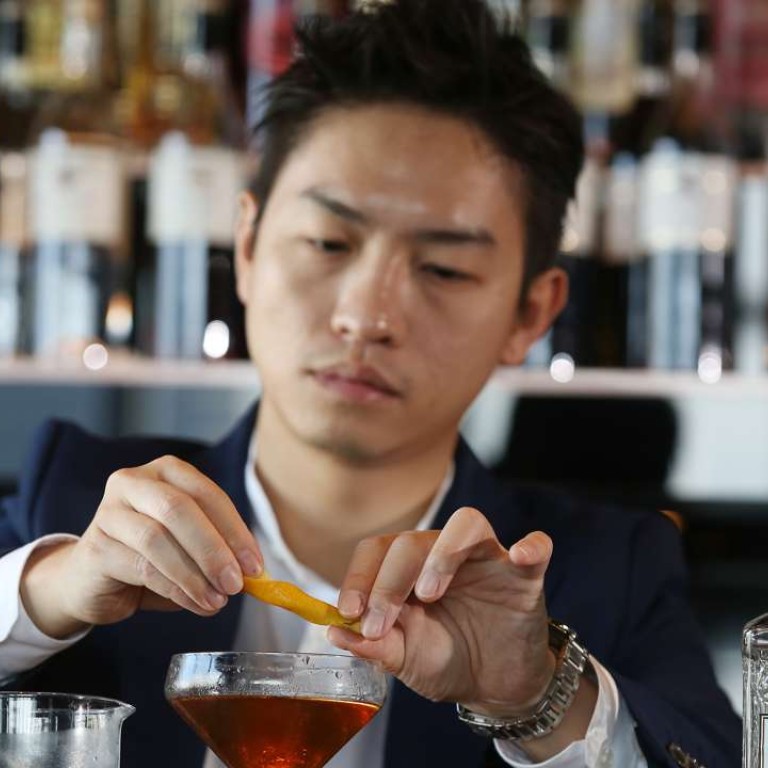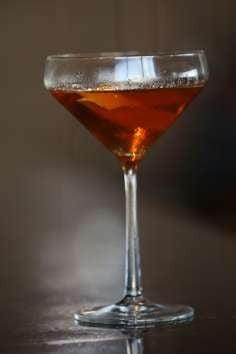
Hong Kong’s best places for a taste of Hanky Panky
The drink, a take on the sweet martini, was created at the American Bar in the Savoy Hotel in London for theatre manager and actor Charles Hawtrey. We look at various versions available in the city
It would be easy to assume that the Hanky Panky, first mixed at the American Bar of the Savoy Hotel in London sometime between 1903 and 1923, was a forerunner of the modern trend towards giving cocktails risqué names.
However, the meaning of the phrase appears to have changed over time. In early 20th century England it seems to have signified something along the lines of “the real deal” or “the real McCoy”.
That, at any rate, was the sense in which the famous actor-manager Charles Hawtrey used it when complimenting Ada “Coley” Coleman – a bartender and eventually head bartender there – on a drink she had prepared specially for him.
Women bartenders in upmarket venues like the American Bar were a rarity in London at the time, and Coleman enjoyed some celebrity status. Some years later in a newspaper interview she recalled creating the Hanky Panky, and credited Hawtrey – who she said was “one of the best judges of cocktails that I knew” – with naming it.
“When he was overworking, he used to come into the bar and say, ‘Coley, I am tired. Give me something with a bit of punch in it’. It was for him that I spent hours experimenting until I had invented a new cocktail. The next time he came in, I told him I had a new drink for him. He sipped it, and, draining the glass, he said, ‘By Jove! That is the real hanky panky!’ And Hanky Panky it has been called ever since.”

It has been suggested that Coleman’s successor at the American Bar – the legendary Harry Craddock, who wrote the influential Savoy Cocktail Book, one of the sacred texts to which modern bartenders still refer – didn’t much care for females in his line of business, and that he and Coleman worked briefly together and didn’t get along.
He included the Hanky Panky in the book, however, although without a credit to its creator. That omission has been rectified in the introduction to recent editions.
Several good interpretations of the drink can be tasted in Hong Kong, although most of them depart somewhat from Coleman’s recipe, at least as relayed by Craddock.
Assuming he was faithful to her original intentions, Coleman’s concoction was a relatively simple variant on a sweet martini, made half and half with gin and vermouth, but with the surprising inclusion of a couple of dashes of Fernet-Branca.
“I know people who take against Fernet-Branca when they first taste it, because they think it’s old- fashioned. Well it is – it has been around for more than 150 years – but it’s now back in fashion. There aren’t many classic cocktails which use it, but it’s in the Hanky Panky,” says Reeve Yip, bar manager at Ce La Vi.
It may not be just because it’s old-fashioned. Drinking Fernet-Branca has been likened to drinking mud. Invented in 1845 and with a recipe which is still a well guarded secret, it is an intensely bitter herbal liqueur. In Italy it is popular as a digestivo, and internationally it has a reputation as an effective hangover cure, possibly because the sheer bitterness is a distraction from the pain.
The taste is also often described as “medicinal”, which is historically apt. Early marketing materials stressed scientifically unproven and in many cases unlikely medicinal benefits. The claims were useful in the United States after the introduction of prohibition; Fernet-Branca could still legally be prescribed as medicine, which gave sales a substantial boost.
Magic cure-all claims aside, used sparingly it can certainly act as an effective counterbalance to the sweet elements in a cocktail; in the case of Ce La Vi’s Hanky Panky, Fernet-Branca is matched with Dolin sweet vermouth.
“This Hanky Panky is a little mellow – not quite like the classic Hanky Panky, which is fairly bold and punchy. This is more silky,” says Yip. “I use Beefeater 24; it’s quite different from the original Beefeater, which is a very classic London dry gin style with more fruity and earthy flavours – pine forest and juniper berries – while Beefeater 24 is more citrus and floral. For the sweet vermouth I’ve used Dolin, which is one of my favourite French brands. The style is balanced between sweetness and bitterness. Most of the modern small-batch vermouth brands are a little bit sweeter. This is a very classic style of vermouth.”
Yip’s Hanky Panky departs significantly from the original recipe in placing a stronger emphasis on the gin, and also on the Fernet-Branca, in a proportion of five parts gin to two parts vermouth and one part – 10ml – Fernet Branca.
He has retained Coleman’s original orange peel garnish – but says if he were making one for himself he would probably substitute another fruit.
“The garnish is a very simple rustic orange twist. Squeeze a little of the oil on top and rub it on the glass, the stem and the sides as well as the rim. You want to get the whole glass with that orange aroma, but you could use grapefruit peel as well, for something a bit different – and it goes particularly well with the Beefeater 24,” says Yip.
He also stirs the drink, although the Savoy Cocktail Book recipe specifies shaking.
“Normally if I make drinks with a high spirit content, I stir. Shaking produces too much unnecessary dilution. It’s single strained into the glass, and all the glassware is chilled, including the mixing glass,” he says.
“In general, cocktails should be balanced. You should get the aroma from the orange. The dominant flavour should be gin with the juniper and botanicals working with the sweetness from the vermouth, but the vermouth should not take over. And finally the herbal flavour from the Fernet-Branca should linger in the mouth. I would drink it as a digestivo. It’s not a drink to open up your appetite or to pair with food, but it is known to be good for digestion.”
There are a number of other bars around town offering classic cocktails where, if a little Hanky Panky is what you are after, you will not seek in vain. Some offer a choice of whisky or gin, and a popular order at Butler in Tsim Sha Tsui is a Hanky Panky made with 18-year-old Chivas Regal.
At Stockton in Wyndham Street the Hanky Panky has been renamed The Hawtrey, in honour of the first man to drink one, and the ingredients changed from London dry gin to Dutch jenever, and from Fernet-Branca to Angostura bitters, mixed with a combination of Maraschino and Italian and French vermouths.
Isono at PMQ has its own variation called the Hanky Panky Lemonade, which involves the classic London dry gin, vermouth and Fernet-Branca combination, topped up with Fever Tree Sicilian lemonade. I wonder what Charles Hawtrey and Ada Coleman would have made of that?
Ce La Vi25/F California Tower, 30-32 D’Aguilar Street, Lan Kwai Fong, tel: 3700 2300
Butler 5/F Mody House, 30 Mody Road, Tsim Sha Tsui, tel: 2724 3828
Stockton 32 Wyndham Street, Central, tel: 2565 5268
Isono 6/F Block B, PMQ, 35 Aberdeen Street, Central, tel: 2156 0688

